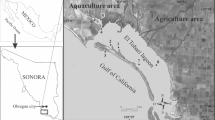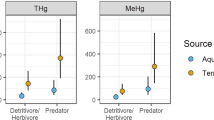Abstract
The water quality, habitats, and biota of streams in the upper Animas River watershed of Colorado, USA, are affected by metal contamination associated with acid drainage. We determined metal concentrations in components of the food web of the Animas River and its tributaries—periphyton (aufwuchs), benthic invertebrates, and livers of brook trout (Salvelinus fontinalis)—and evaluated pathways of metal exposure and hazards of metal toxicity to stream biota. Concentrations of the toxic metals cadmium (Cd), copper (Cu), lead (Pb), and zinc (Zn) in periphyton, benthic invertebrates, and trout livers from one or more sites in the upper Animas River were significantly greater than those from reference sites. Periphyton from sites downstream from mixing zones of acid and neutral waters had elevated concentrations of aluminum (Al) and iron (Fe) reflecting deposition of colloidal Fe and Al oxides, and reduced algal biomass. Metal concentrations in benthic invertebrates reflected differences in feeding habits and body size among taxa, with greatest concentrations of Zn, Cu, and Cd in the small mayfly Rhithrogena, which feeds on periphyton, and greatest concentrations of Pb in the small stonefly Zapada, a detritivore. Concentrations of Zn and Pb decreased across each trophic linkage, whereas concentrations of Cu and Cd were similar across several trophic levels, suggesting that Cu and Cd were more efficiently transferred via dietary exposure. Concentrations of Cu in invertebrates and trout livers were more closely associated with impacts on trout populations and invertebrate communities than were concentrations of Zn, Cd, or Pb. Copper concentrations in livers of brook trout from the upper Animas River were substantially greater than background concentrations and approached levels associated with reduced brook trout populations in field studies and with toxic effects on other salmonids in laboratory studies. These results indicate that bioaccumulation and transfer of metals in stream food webs are significant components of metal exposure for stream biota of the upper Animas River watershed and suggest that chronic toxicity of Cu is an important factor limiting the distribution and abundance of brook trout populations in the watershed.
Similar content being viewed by others
Author information
Authors and Affiliations
Additional information
Received: 4 April 2000/Accepted: 31 July 2000
Rights and permissions
About this article
Cite this article
Besser, J., Brumbaugh, W., May, T. et al. Bioavailability of Metals in Stream Food Webs and Hazards to Brook Trout (Salvelinus fontinalis) in the Upper Animas River Watershed, Colorado. Arch. Environ. Contam. Toxicol. 40, 48–59 (2001). https://doi.org/10.1007/s002440010147
Issue Date:
DOI: https://doi.org/10.1007/s002440010147




